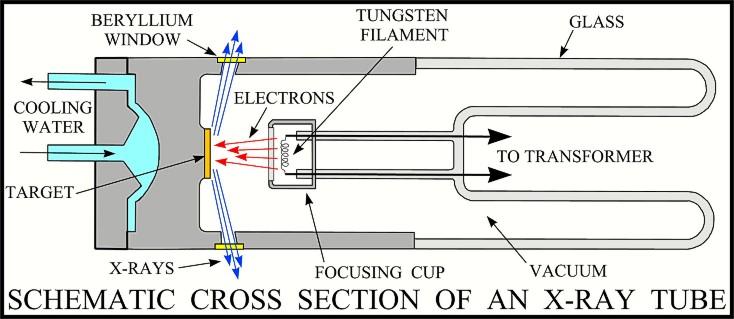This piece is an example of a standard x-ray tube. These devices have been used to produce x-rays for diffraction experiments for decades, and many of the other devices in the crystallography display in the museum rely on a source such as this. The device has been separated into two sections - the left metallic section is the anode, and the right section is the cathode and filament. The entire device is enclosed in a perspex case, because the windows of the anode are made from beryllium, which is poisonous. Beryllium is used because its low atomic weight ensures it has a low level of x-ray absorption.
A current is run through a filament, nowadays usually a tungsten filament, which causes it to heat. Electrons are then ejected from the filament once they gain enough thermal vibrational energy. In order to guide the path of electrons once they are ejected, the filament is located inside what is called a focusing cup which is a small dish-shaped depression made of molybdenum. This guided stream of electrons is accelerated towards a target anode.
When the electrons strike the metal plate on the anode, two forms of x-ray radiation occur. As the incident electrons decelerate upon striking, they emit Bremsstrahlung x-rays, or “braking radiation” x-rays from German. These x-rays are emitted over a continuous spectrum. Conversely, the remaining x-rays are produced when the incident electrons fully collide with the anode and displace the low-orbital electrons in the anode. Higher energy electrons then then cascade downwards to fill these gaps, emitting x-rays as they shed excess energy. The wavelength of these x-rays depends on the difference in the atomic energy level of the cascading electrons. X-rays produced in this manner are known as Characteristic x-rays, and produce a discrete series of x-ray wavelengths.
PANalytical is a subsidiary of Philips, a Netherlands-based manufacturer of scientific equipment.They have offices in Japan, China, Brazil, the USA and the Netherlands. In 2002 PANalytical was sold and now operates as a subsidiary of Spectris plc, a UK-based technology company. Their research includes X-ray instruments and tubes, XRF applications and standards, fusion sample preparation and near-infrared instruments.
This item is part of the UQ Physics Museum Crystallography Tour
< Previous Item | Return to Tour Menu | Next Item >
JDB, SN
